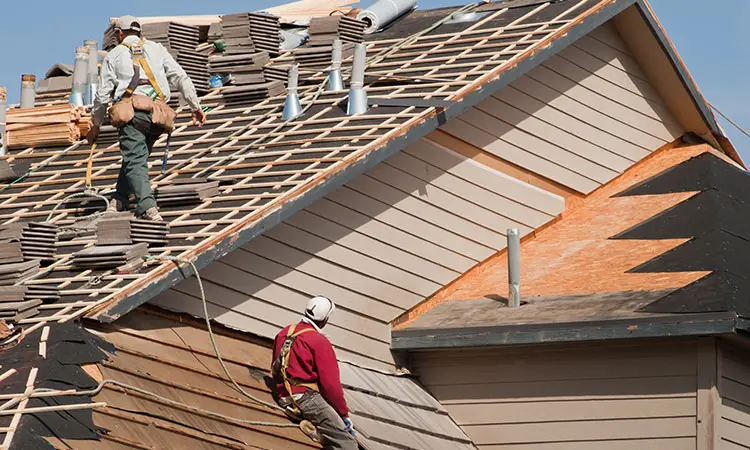A Thorough Overview of Roof Covering Substitute Options: Evaluating the Best Roof Covering Materials for Your Climate and Spending Plan
When contemplating a roof substitute, comprehending the interaction in between environment problems and material choice is crucial. Each roof covering choice, from affordable asphalt roof shingles to resilient steel and traditional clay tiles, provides distinct advantages and difficulties.
Understanding Climate Effect
Recognizing the environment influence on roofing replacement is critical for homeowners considering this considerable financial investment. Numerous weather problems can considerably affect both the performance and longevity of roof materials. Areas with severe temperature levels might necessitate roof covering systems that provide premium insulation residential properties to regulate interior temperatures efficiently. In regions vulnerable to heavy rains, choosing materials with enhanced waterproofing capabilities is important to prevent leakages and water damage.

It is likewise crucial to take into consideration the ecological influence of roof covering products in relation to regional climate. Sustainable alternatives that reflect warm can aid alleviate city warmth island results, while energy-efficient materials can add to lower energy consumption. By comprehending these climate factors, home owners can make enlightened decisions that align with their particular ecological conditions, ultimately boosting the strength and performance of their roof covering investments.
Popular Roofing Materials
Picking the best roof covering product is necessary for ensuring toughness, aesthetics, and energy effectiveness in a home. Numerous roof materials are popular among property owners, each offering one-of-a-kind advantages matched to various environments and architectural designs.
Asphalt tiles are amongst the most widely used choices due to their affordability, simplicity of installation, and convenience. Steel roof, including aluminum and steel, is highly sturdy and can withstand harsh weather condition conditions, making it ideal for locations vulnerable to extreme environments.
Clay and concrete tiles are favored for their longevity and distinctive appearance, usually seen in Mediterranean and Southwestern architecture. They offer exceptional insulation however can be heavier, calling for enhanced frameworks. Slate roof is an additional costs selection understood for its impressive long life and all-natural charm, though it requires a greater ahead of time investment and competent installation.
Cost Contrast of Choices
When considering a roofing system replacement, the economic ramifications of various products play an important duty in the decision-making procedure. The prices connected with roofing products can differ dramatically, affected by variables such as material type, setup intricacy, and local rates variations.
Asphalt roof shingles, recognized for their cost, typically vary from $90 to $100 per square (100 square feet), making them an economical choice for budget-conscious home owners (Coffs Harbour Roof Replacements). On the other hand, metal roof covering, while much more long lasting, can set you back in between $150 to $300 per square, depending upon the kind of steel used and the details of the setup
For those seeking aesthetic charm and longevity, choices like clay or concrete ceramic tiles can range from $300 to $1,000 per square, reflecting their costs prices. Furthermore, slate roofing can get to upwards of $800 to $1,500 per square, making it one of one of the most expensive materials readily available.
Inevitably, when evaluating roof covering choices, it is crucial to balance ahead of time expenses with the potential long-term advantages and energy financial savings. An in-depth price evaluation will certainly try here ensure property owners make educated selections that align with their economic abilities and roof covering demands.
Durability and Upkeep
The longevity and upkeep requirements of roofing materials are vital variables that can considerably influence a house owner's overall investment. Different roof covering options show differing life expectancies and maintenance needs, which can impact lasting costs and performance.

Clay and concrete ceramic tiles provide excellent longevity, usually exceeding 50 years, yet they can be delicate and necessitate cautious upkeep to prevent breaking. Timber shingles and trembles can last around 30 years yet are susceptible to rot and insect damage, requiring vigilant maintenance to keep their integrity.
Eventually, the choice of roof covering material need to straighten not just with budgetary restraints however also with the desired long life and upkeep degree. Recognizing these elements can aid house owners make informed decisions that shield their investment and guarantee the roof covering remains functional and visually pleasing throughout its life expectancy.
Making Your Decision

Following, evaluate the life-span and guarantee associated with each material. Some items might have a higher in advance price however offer greater long life and reduced maintenance requirements, inevitably saving you cash over time. It's vital to think about the compromises in between initial financial investment and lasting efficiency.
Budget see this page restrictions ought to likewise guide your decision. Allot funds not only for the roofing materials however additionally for setup, which can vary based upon intricacy and labor prices. Acquire numerous quotes from credible service providers to article make certain a reasonable analysis of setup expenses.
Last but not least, think about the visual allure and how it aligns with your home's total layout. An appropriate roofing boosts aesthetic allure and can raise residential or commercial property worth - Roofer Coffs Harbour. Weigh these elements meticulously to make an enlightened choice that satisfies both your functional needs and monetary abilities
Final Thought
In final thought, selecting the appropriate roof covering product requires cautious factor to consider of neighborhood environment, budget plan constraints, and the one-of-a-kind buildings of numerous materials. Asphalt tiles supply affordability, while steel roof covering provides exceptional durability, and clay tiles make sure longevity.
Numerous weather conditions can dramatically affect both the performance and durability of roof products.It is additionally vital to take into consideration the environmental impact of roof products in relation to regional environment. Begin by evaluating your neighborhood environment, as this substantially affects the efficiency of roof covering materials. Designate funds not only for the roofing products but also for setup, which can vary based on complexity and labor expenses.In final thought, picking the proper roof covering product requires cautious consideration of regional climate, budget constraints, and the one-of-a-kind homes of different products.